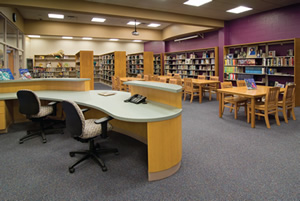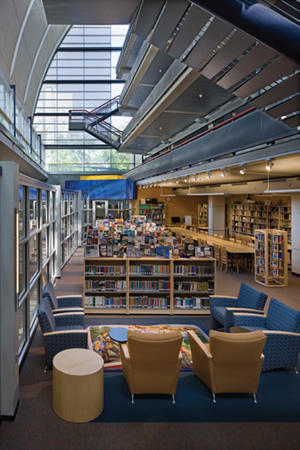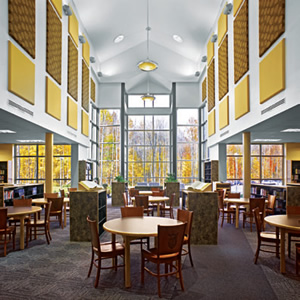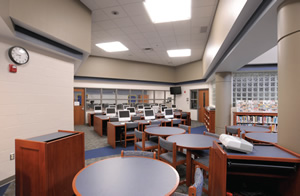Building Blueprints (Facilities in Focus)
Libraries Media Centers
- By David Krutz
- June 1st, 2015

PHOTOS COURTESY OF THE RUHLIN COMPANY
School libraries and media centers are one of the most symbolic, protected and expensive spaces on any school campus. With the fastpaced revolution of technology impacting facilities around the world, fundamental and provocative changes are beginning to challenge the traditional role of the school library’s space and purpose.
To remain relevant, libraries will need to adapt and redefine their “value-added” purpose. Many people seeking information no longer need to visit a physical space in order to fulfill their information needs. Yet there is a growing body of research demonstrating the positive effect school libraries and librarians have on student reading abilities and academic achievement. The physical presence of libraries and media centers in schools will continue to be important, but library staff will need to expand programs beyond physical walls to create virtual libraries capable of serving the needs of the students, wherever they are.
Evolving functionality
The right balance must be struck during the planning stage between tradition and innovation when it comes to protecting the core principles of a library or media center. Traditional library environments are text-based and primarily constructed for individual use; their purpose is to teach people how to efficiently find and use the information they need. Today’s library is a dynamic learning space, not a book warehouse. The space must be a fluid environment, adapting to the ever changing ways of exchanging ideas and information, and able to continually reinvent itself to remain vibrant and relevant.

PHOTOS COURTESY OF THE RUHLIN COMPANY
Students have become accustomed to multitasking, working in groups and being surrounded by multimedia environments, and libraries must reflect these trends, mirroring the multiple activities that can take place simultaneously in modern learning environments. Since there are many different styles of learning, the library should also reflect this variety with as many different learning spaces as possible — quiet study areas, group activity areas, spaces for individual and small group work, instructional areas and even areas where food and drink are allowed. Visit your local coffee shop to quickly understand that kids today want a social learning space where information can be shared, not just absorbed.
Design is key
When designing a library space, it’s important to have the library program and staff in place before facility planning begins to understand the media center’s philosophy, mission and how many people will use the space. Experienced and reputable school library facility consultants should be engaged to review the developing program of requirements and guide the design team and stakeholders through the process. Modern school libraries are complex spaces required to perform multiple roles simultaneously, and as such, need to be carefully designed to avoid being too conservative and uninviting. The design should be bold and exciting, especially in providing flexible spaces and comfortable furnishings to entice students and teachers to make daily use of the space’s offerings.

PHOTOS COURTESY OF THE RUHLIN COMPANY
Blending levels of technology
Physical considerations need to be carefully addressed: the number and location of data and electrical outlets, wireless access points, the quality and level of lighting in different areas, the acoustical considerations both inside the space and from outside sources, and the type of media that will be accessed. Older technologies don’t necessarily go away; the book, the radio, the telephone, the movie, the television, the CD-ROM and the internet all currently provide people with information and will probably continue to do so for the foreseeable future. These technologies need to be factored into the overall design and layout of the library space, with consideration given to how they will be accessed.
Traffic flow patterns need to be analyzed to ensure that spaces such as the reading/study areas are away from the high-traffic and noise-generating spaces such as meeting rooms and video conferencing areas. The library needs to be accessible from the rest of the school, but not a passageway between areas of the building. Will the resources be made available to the public after school hours? Should the rest of the building be accessible as well, or does the library need to stand alone in terms of restrooms, drinking fountains and climate control? Will a separate outside entry be required with parking nearby? How the library will be used and by whom will help shape its layout.

PHOTOS COURTESY OF THE RUHLIN COMPANY
A good school library or media center is more than a book repository — it should be the school’s information hub and an environment to support multiple learning activities, styles and media formats. The amount of information available to students and teachers is overwhelming and continues to grow at a staggering pace. Libraries, and the librarians that staff them, can help guide and teach students and staff to cope with information overload and focus on what is meaningful and relevant to today’s curriculum. A well-executed library program is a place where students can develop the skills and proficiencies necessary to succeed and embody the “ongoing, voluntary and self-motivated ” concepts of the lifelong learner.
This article originally appeared in the June 2015 issue of School Planning & Management.
About the Author
David Krutz is a project manager with The Ruhlin Company, a full-service construction firm located in Northeast Ohio. With more than 31 years of construction management experience, David’s building expertise is focused on K-12 facilities.